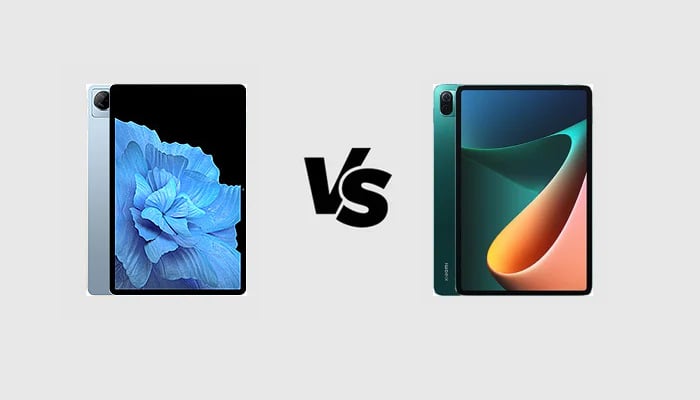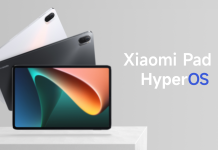Vivo officially entered the tablets market with its first device: the Vivo Pad. Despite being its first tablet, it comes with high-end specifications, including the 5G connectivity, but it is not the most powerful tablet out there in order to provide a great quality price ratio as well. Just like the Xiaomi Pad 5: another high-end tablet available at great prices. This comparison between the specifications of the Vivo Pad and the Xiaomi Pad 5 will hopefully help you to make the best choice and let you understand which of these tablets offers the highest value for money. After reading the comparisons, you can let us know your opinion by using the comment box below.

Realme Pad vs Xiaomi Mi Pad 5
| Vivo Pad | Xiaomi Mi Pad 5 | |
|---|---|---|
| DIMENSIONS AND WEIGHT | 253.2 x 164.7 x 6.6 mm, 489 grams | 254.7 x 166.3 x 6.9 mm, 511 g |
| DISPLAY | 11 inches, 1600 x 2560p (Quad HD+), IPS LCD | 11 inches, 1600 x 2560p (Quad HD+), IPS LCD |
| PROCESSOR | Qualcomm Snapdragon 870, octa-core 3.2 GHz | Qualcomm Snapdragon 860, octa-core 2.96 GHz |
| MEMORY | 8 GB RAM, 128 GB – 8 GB RAM, 256 GB | 6 GB RAM, 128 GB – 6 GB RAM, 256 GB |
| SOFTWARE | Android 12, OriginOS HD | Android 11, MIUI |
| CONNECTIVITY | Wi-Fi 802.11 a/b/g/n/ac/ax, Bluetooth 5.2, GPS | Wi-Fi 802.11 a/b/g/n/ac, Bluetooth 5.0, GPS |
| CAMERA | Dual 13 + 8 MP f/2.2 + f/2.2 8 MP f/2.0 front camera |
Single 13 MP f/2.0 8 MP f/2.0 front camera |
| BATTERY | 8040 mAh, fast charging 44W | 8720 mAh, fast charging 33W |
| ADDITIONAL FEATURES | Optional 5H, stylus support, keyboard support, reverse charging | Pen support, keyboard support |
Design
The Vivo Pad and Xiaomi Pad 5 come with a great design. They both have very narrow bezels around the display, as well as a very thin and lightweight body. The Vivo Pad wins the comparison because it comes with better materials: it has an aluminum unibody design, while the Xiaomi Pad 5 has just an aluminum frame, while the rear side is made of polycarbonate. Further, the Xiaomi tablet is thicker and heavier than the Vivo rival. Both the devices support a keyboard and a stylus for handwriting and drawing. They have no audio jack and no fingerprint readers.
Display
It looks like the Xiaomi Pad 5 has a better display. It is an IPS LCD panel, but it provides great image quality thanks to advanced specifications. This panel comes with a diagonal of 11 inches, a Quad HD+ resolution of 1600 x 2560 pixels, one billion colors, a 120 Hz refresh rate, the HDR10 certification, and Dolby Vision. The display is paired with four stereo speakers. The Vivo Pad has an 11-inch display as well, with a 120 Hz refresh rate, the same Quad HD Plus resolution, and the HDR10 certification (further, you get four stereo speakers here as well). But this panel does not show up to one billion colors and it lacks Dolby Vision support.
Specs & Software
The most advanced hardware department belongs to the Vivo Pad. It is fueled by the Snapdragon 870 mobile platform built at 7 nm, with a max frequency of 3.2 GHz and 5G connectivity. The chipset is paired with 8 GB of RAM and up to 256 GB of internal storage. The Xiaomi Pad 5 is powered by a weaker Snapdragon 860 chipset and it lacks 5G connectivity. So you not only get lower CPU and GPU performance, but you also have to renounce cellular connectivity. Vivo Pad runs Android 12 out of the box customized by OriginOS HD, a special version of the OriginOS customization developed to take advantage of the tablet’s form factor. The Xiaomi Pad 5 is still based on Android 11, customized by MIUI 12.5.
Camera
If you are looking for a superior camera department, then choose the Vivo Pad. Both come with a pretty nice (for a tablet) 13 MP camera, but the Vivo tablet adds an 8 MP ultrawide sensor making the camera setup more versatile. These tablets are able to record 4K videos with the rear camera and 10880p videos with their 8 MP front cameras.
- Read More: Xiaomi Mi Pad 5 & Mi Pad 5 Pro Official: 11″, 120Hz refresh rate, 5G, MIUI for Pad & more!
Battery
The Xiaomi Pad 5 is equipped with a bigger 8720 mAh battery and its battery life is longer. On the other hand, the Vivo Pad charges quicker not only because of its smaller battery but also because it supports 44W fast charging. You can even use it as a power bank thanks to reverse charging.
Price
The starting price of the Vivo Pad for the Chinese market roughly translates into €360/$388 at the actual change, for the base variant with 8 GB of RAM and 128 GB of internal storage. The Xiaomi Pad 5 sells for €350/$377 in its base variant with 6 GB of RAM and 128 GB of native storage, but it is available at better street prices. The Vivo Pad wins the comparison because it has a better chipset, 5G connectivity, an ultrawide camera, and faster charging. But the Xiaomi Pad 5 actually comes with a better display (even though it remains an IPS panel) and a bigger battery. Further, it is available at better prices, so it can let you save money if you do not need an ultrawide camera and 5G.
Vivo Pad vs Xiaomi Mi Pad 5: PRO and CONS
Vivo Pad
PRO
- Better chipset
- 5G
- Ultrawide camera
- Faster charging
- Reverse charging
CONS
- Smaller battery
Xiaomi Mi Pad 5
PRO
- Bigger battery
- One billion colors
- More affordable
CONS
- Inferior hardware and camera
RELATED







